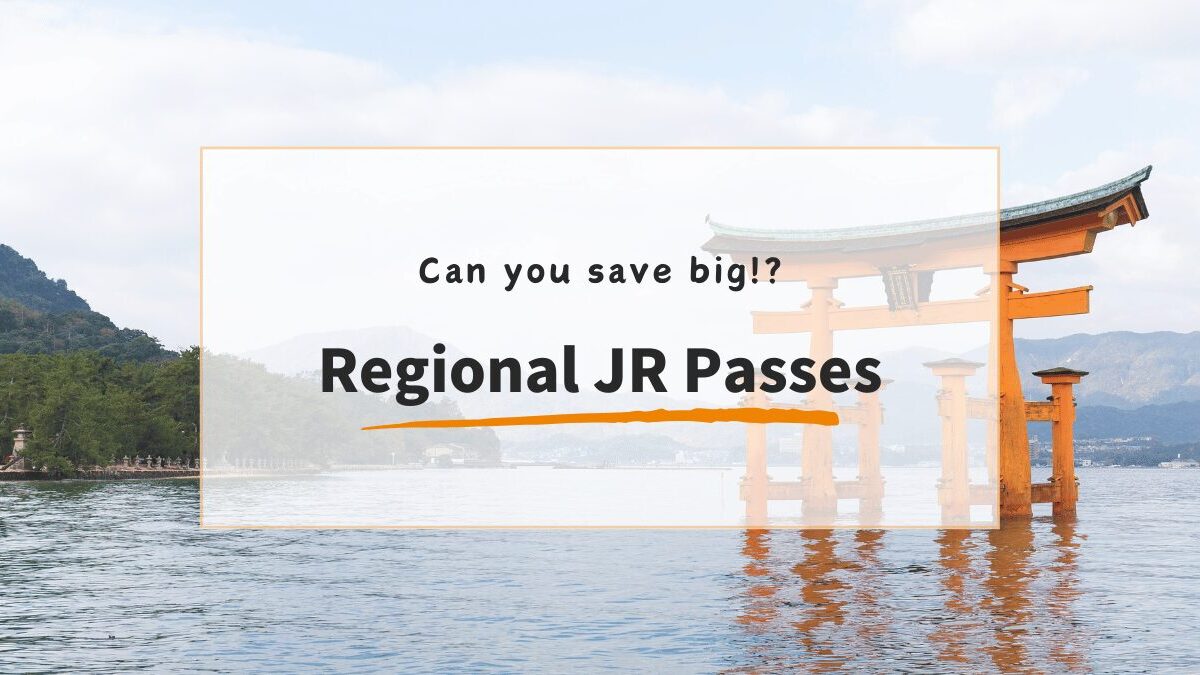Planning your first trip to Japan can be both exciting and overwhelming. One of the key decisions you’ll need to make is whether to purchase a JR Pass, and if so, which one. With so many options available, it’s easy to feel confused.
We totally understand the desire to get the best value for your money while ensuring your pass fits perfectly with your travel itinerary. That’s where the Regional JR Passes come in—while the nationwide JR Pass is popular, regional passes can provide excellent alternatives tailored to your travel.
In this post, we will focus on JR West Regional Passes which are available in Kansai area and part of Kyushu.
- Difference between JR Pass and Regional JR Passes
- About Regional JR Passes in JR West (Kansai) area
Understanding the Differences: JR Pass vs. Regional JR Passes
What are the differences between the JR Pass and the Regional JR Pass?
Japan Railways (JR) is divided into six main regional companies, each serving different areas of the country.
The Japan Rail Pass can be used throughout Japan, while Regional JR passes are valid within specific JR regions. These passes are a cost-effective option for travelers who plan to explore a particular area of Japan extensively.

| JR Pass | Regional JR Passes | |
|---|---|---|
| Coverage | Nationwide in Japan | Specific regions |
| Validity Period | 7, 14, 21 days | Varies by pass, typically 1 to 7 days |
| Price | Two types: Ordinary and Green Car (First Class), varies by duration | Varies by region, generally cheaper than JR Pass |
| Shinkansen (bullet train) use | Can ride most Shinkansen, but not “Nozomi” or “Mizuho” * | Some regional passes allow Shinkansen within the region, but not outside the region |
| Pass Exchange Offices | Major airports, and major JR stations | Major JR stations in the region |
| PROS | 1. Nationwide Coverage 2. Cost-Effective for Long Trips 3. Convenience | 1. Cost-Effective for Specific Areas 2. Focused Coverage |
| CONS | 1. Cannot use on Nozomi/Mizuho 2. Not ideal for Short Trips | 1. Limited Coverage 2. Fewer Options for Long Distances |
Key Benefits of Regional JR Passes
- Cost-Effectiveness: Ideal for travelers focusing on specific regions.
- Focused Coverage: Perfect for short trips and exploring local attractions.
- Speed: Some Regional JR Passes allow you to use the Nozomi and Mizuho trains, Japan’s fastest bullet train services.

How to Choose the Right JR Pass

Choosing the right area pass depends on your travel itinerary and plans. Here are some steps to help you determine which JR pass to purchase:
- Identify Your Destinations: List the cities and regions you plan to visit. This will help you see which JR regional company operates in those areas.
- Compare Pass Coverage: Look at the specific coverage of each Regional JR pass. Some passes cover multiple regions or specific scenic routes, so compare them against your destinations.
- Duration of Stay: Check the validity period of each pass. Some passes are available for 5, 7, or 14 days. Choose one that matches the length of your stay.
- Compare Costs: Calculate the total cost of individual tickets for your planned travel versus the price of a Regional pass. This will help you see potential savings.
Traveling in Kansai – Kyoto, Nara, Osaka, and Kobe

Most of the JR West Passes with the word “Kansai” cover these main Cities.
- Kyoto
- Nara
- Osaka
- Kobe
If you’re planning to stay in this area, it’s a good idea to compare these three Regional Passes. Check JR West website for more detail.
| Kansai Area Pass | Kansai WIDE Area Pass | Kansai Mini Pass | |
|---|---|---|---|
| Coverage | Kyoto, Nara Osaka, Kobe Kansai Airport (KIX) Himeji Wakayama | Kyoto, Nara, Osaka, Kobe, Kansai Airport, Himeji, Wakayama, Tottori, Okayama, Takamatsu | Kyoto Nara Osaka Kobe Kansai Airport (KIX) |
| Validity Period | 1 day – 4 day | 5 day | 3 day |
| Price | 2,800 yen – 7,000 yen | 12,000 yen | 3,000 yen |
| Shinkansen (bullet train) use in the area | X | O | X |
Traveling from Kyoto to Hakata

If you’re planning to travel from Kyoto to Hakata (Fukuoka), these three Regional pass options may work for you.
| Sanyo-San’in Area Pass | JR-WEST All Area Pass | Sanyo-San’in Northern Kyushu Pass | |
|---|---|---|---|
| Coverage | Kyoto, Nara, Osaka, Kobe, Kansai Airport, Himeji, Wakayama, Tottori, Okayama, Hiroshima, Hakata, Takamatsu | Kyoto, Nara, Osaka, Kobe, Kansai Airport, Himeji, Wakayama, Tottori, Okayama, Hiroshima, Hakata, Kanazawa | Kyoto, Nara, Osaka, Kobe, Kansai Airport, Himeji, Wakayama, Tottori, Okayama, Hiroshima, Hakata, Takamatsu, Nagasaki |
| Validity Period | 7 day | 7 day | 7 day |
| Price | 23,000 yen | 26,000 yen | 26,000 yen |
| Shinkansen (bullet train) use in the area | O | O | O |
Who Benefits Most?
Ideal for travelers planning to visit multiple cities across Japan beyond just Shin-Osaka and Hakata. If you intend to explore various regions within a week, the JR Pass offers great flexibility and value.
Best for travelers focusing solely on the Kyushu region or those making a short trip between Shin-Osaka and Hakata. It is a cost-effective option for those who do not plan to travel extensively outside the designated area.
Conclusion: Make the Most of Your JR Pass
Choosing the right JR Pass can significantly enhance your travel experience in Japan. Whether you’re exploring the Kansai region or planning to venture into Kyushu, understanding your options will help you save money and make the most of your trip. Check the JR West website for detailed information and to purchase your pass.


